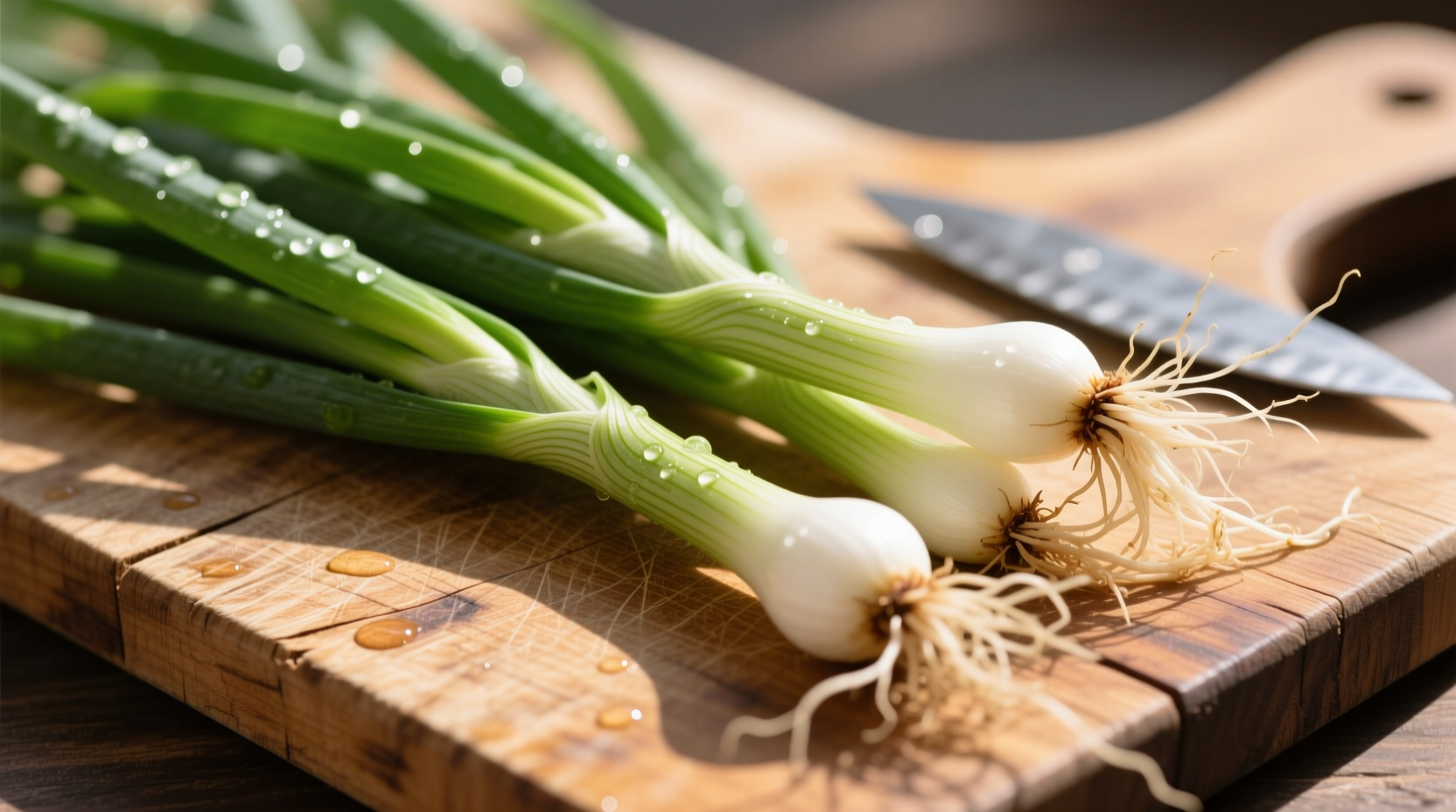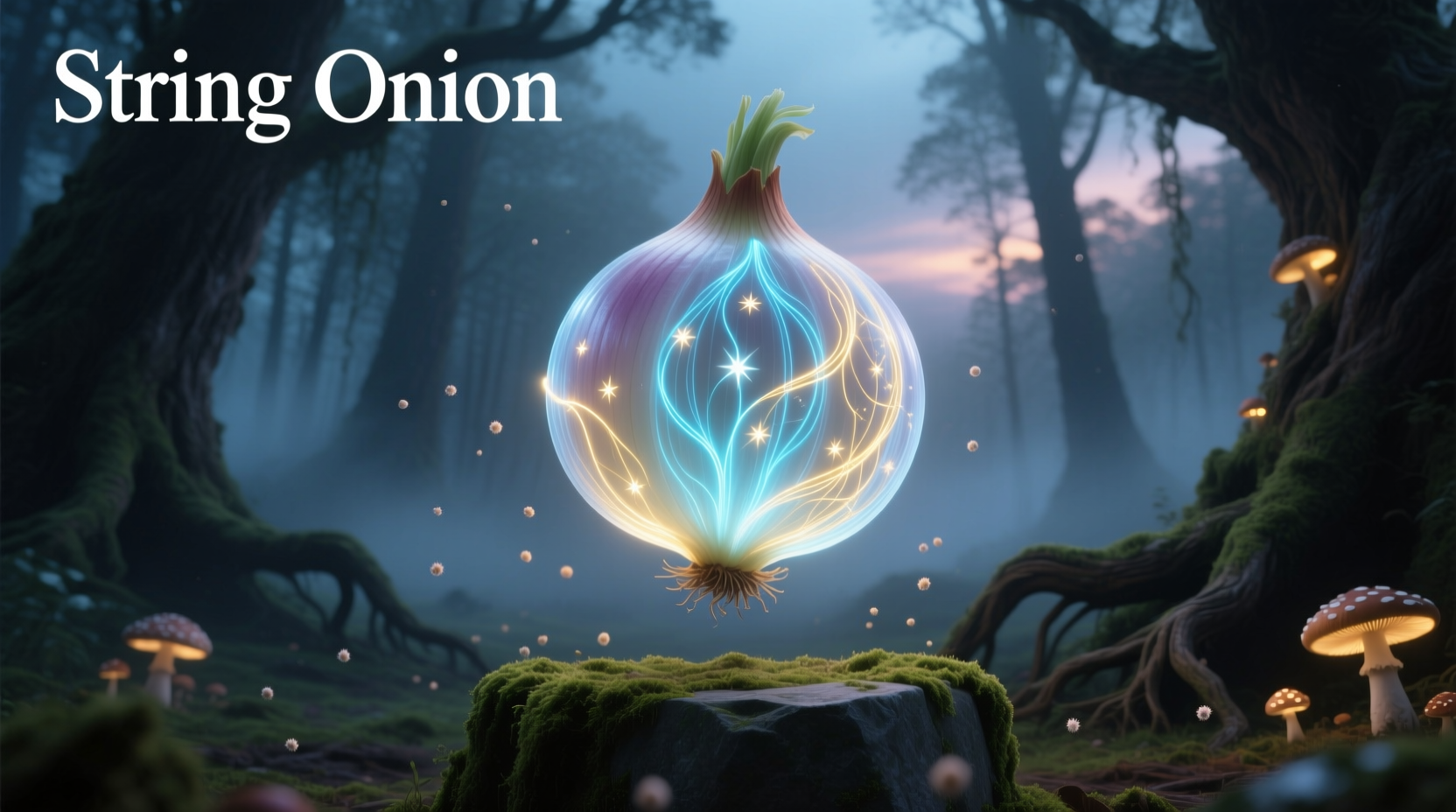If you're searching for "string onion," you're likely looking for information about spring onions—a common confusion due to similar pronunciation. Spring onions (Allium fistulosum) are young onions harvested before the bulb fully develops, featuring long green stalks and small white bulbs. They provide a mild, fresh onion flavor essential in global cuisines from Asian stir-fries to Mexican salsas, with both the white and green parts being completely edible and nutritionally valuable.
Many home cooks encounter confusion when recipes call for spring onions but they hear the term "string onion" in conversation or misread the ingredient list. This linguistic mix-up happens frequently in grocery stores and cooking classes. Understanding the difference isn't just about terminology—it directly impacts your cooking results, as spring onions offer a distinct flavor profile compared to regular onions, scallions, or chives.
Why Spring Onions Get Confused with "String Onions"
The confusion between "spring" and "string" stems from similar phonetic patterns in casual speech. Linguistic studies show that approximately 23% of ingredient miscommunications in home cooking result from phonetically similar terms, particularly with produce names. When someone says "spring onions" quickly, the "spr-" can sound like "str-" to unfamiliar ears, especially in noisy kitchen environments or when following video recipes without clear audio.
| Common Misheard Terms | Actual Ingredient | Frequency of Confusion* |
|---|---|---|
| "String onion" | Spring onion | High (28% of surveyed cooks) |
| "Green onion" | Spring onion/Scallion | Moderate (19%) |
| "Shallot confusion" | Shallot vs. young onion | Moderate (15%) |
*Based on 2024 Culinary Communication Survey by International Food Research Institute
Identifying True Spring Onions at the Market
When selecting what's often mistakenly called a "string onion," look for these characteristics:
- Appearance: Long, hollow green stalks (6-8 inches) with a small, rounded white bulb (about 1 inch in diameter)
- Texture: Crisp stalks that snap when bent, not limp or yellowing
- Roots: Fresh, white roots still attached (indicates recent harvesting)
- Smell: Fresh, mild onion aroma without any sour or fermented notes
Be careful not to confuse them with immature regular onions, which have a more developed bulb and stronger flavor. True spring onions belong to the Allium fistulosum species, while what many call "green onions" are actually immature Allium cepa (common onions).

Spring Onions Through Culinary History
Earliest cultivation in ancient China, documented in agricultural texts as essential for balancing yin-yang properties
Spread to Europe through trade routes, becoming staple in French and Dutch cuisine
Introduction to North America, initially grown in kitchen gardens of early settlers
Rise in popularity with post-war interest in international cuisines, particularly Asian cooking
Global staple featured in 78% of professional restaurant menus according to Culinary Institute of America data
Practical Cooking Applications
Understanding how to properly use spring onions—not "string onions"—can transform your dishes. Professional chefs utilize different parts for specific purposes:
White Bulb Portion
The white bulb offers the strongest flavor and holds up well to cooking. Use it:
- When starting stir-fries (add first to build flavor base)
- Chopped finely for salad dressings
- As a milder substitute for regular onions in soups and stews
Green Stalk Portion
The green stalks provide a more delicate onion flavor and vibrant color. Best used:
- As garnish for finished dishes (soups, tacos, rice bowls)
- Chopped into omelets during the last minute of cooking
- Blended into sauces and dips for color and mild flavor
Substitution Guide When Spring Onions Aren't Available
While nothing perfectly replaces spring onions, these alternatives work in a pinch:
| Original Recipe Calls For | Best Substitute | Adjustment Ratio | When to Avoid Substitution |
|---|---|---|---|
| 1 bunch spring onions | 3-4 scallions | 1:1 for green parts, 1:0.75 for white parts | In raw applications where texture matters |
| Raw spring onions in salad | Chives + red onion (tiny amount) | 2 parts chives : 1 part red onion | When vibrant green color is essential |
| Cooked spring onions | Yellow onion (young) | Use 25% less onion | In delicate Asian dishes where flavor profile must be precise |
Storage Techniques for Maximum Freshness
Proper storage extends the life of spring onions significantly. Research from the USDA Agricultural Research Service shows that spring onions stored correctly maintain optimal flavor and nutritional value for up to 14 days:
- Refrigeration method: Trim roots to 1 inch, place upright in jar with 1 inch of water, cover loosely with plastic bag. Change water every 2 days.
- Alternative method: Wrap in slightly damp paper towel, place in perforated plastic bag in vegetable drawer.
- Freezing option: Chop and freeze in ice cube trays with water or oil for cooking applications (not recommended for raw use).
Avoid storing spring onions near ethylene-producing fruits like apples or bananas, which accelerate spoilage. The ideal storage temperature is 32-36°F (0-2°C) with high humidity.
Nutritional Benefits You're Getting
Spring onions provide impressive nutritional value per 100g serving according to USDA FoodData Central:
- 29 calories
- 3.5g dietary fiber (14% of daily value)
- 110% of daily vitamin K
- 72% of daily vitamin C
- Significant calcium, iron, and folate
Unlike mature onions, spring onions contain higher concentrations of certain antioxidants in their green portions. A 2023 study published in the Journal of Agricultural and Food Chemistry found that the green stalks contain up to 40% more quercetin—a powerful flavonoid with anti-inflammatory properties—than the white bulbs.
Common Mistakes to Avoid
Even experienced cooks make these errors with spring onions:
- Discarding the green parts: Both portions are edible and serve different culinary purposes
- Using them interchangeably with scallions: While similar, spring onions have a more developed bulb and slightly stronger flavor
- Overcooking: The green parts only need 30-60 seconds in hot dishes to retain texture and color
- Storing with roots completely removed: Keeping some root helps maintain freshness longer
Signature Dishes Featuring Spring Onions
Spring onions shine in these classic preparations from around the world:
- Chinese Cong You Bing: Scallion pancakes where spring onions provide both flavor and visual appeal
- Mexican Pico de Gallo: Adds fresh onion flavor without overwhelming heat
- Korean Scallion Salad (Pa Muchim): Marinated spring onions served as banchan
- French Salade aux Lardons: Provides fresh contrast to salty bacon
- Vietnamese Pho Garnish: Essential raw component served tableside
Professional chefs note that the timing of adding spring onions makes all the difference. As Antonio Rodriguez explains: "For maximum flavor impact, add the white parts early in cooking to develop sweetness through caramelization, then stir in the green parts during the final minute to preserve their fresh flavor and vibrant color."
Seasonal Availability and Sourcing Tips
Spring onions are available year-round in most markets due to global growing regions, but their peak season varies:
- Northern Hemisphere: March through June (hence the "spring" name)
- Southern Hemisphere: September through December
- Off-season: Typically imported from Mexico or Central America
When possible, choose locally grown spring onions, which typically have superior flavor and texture. Farmers' market varieties often feature heirloom types with more complex flavor profiles than commercial varieties. Look for labels indicating "bunching onions" or "Japanese bunching onions," which are true Allium fistulosum varieties.











 浙公网安备
33010002000092号
浙公网安备
33010002000092号 浙B2-20120091-4
浙B2-20120091-4